2015 NISSAN TITAN differential
[x] Cancel search: differentialPage 134 of 457
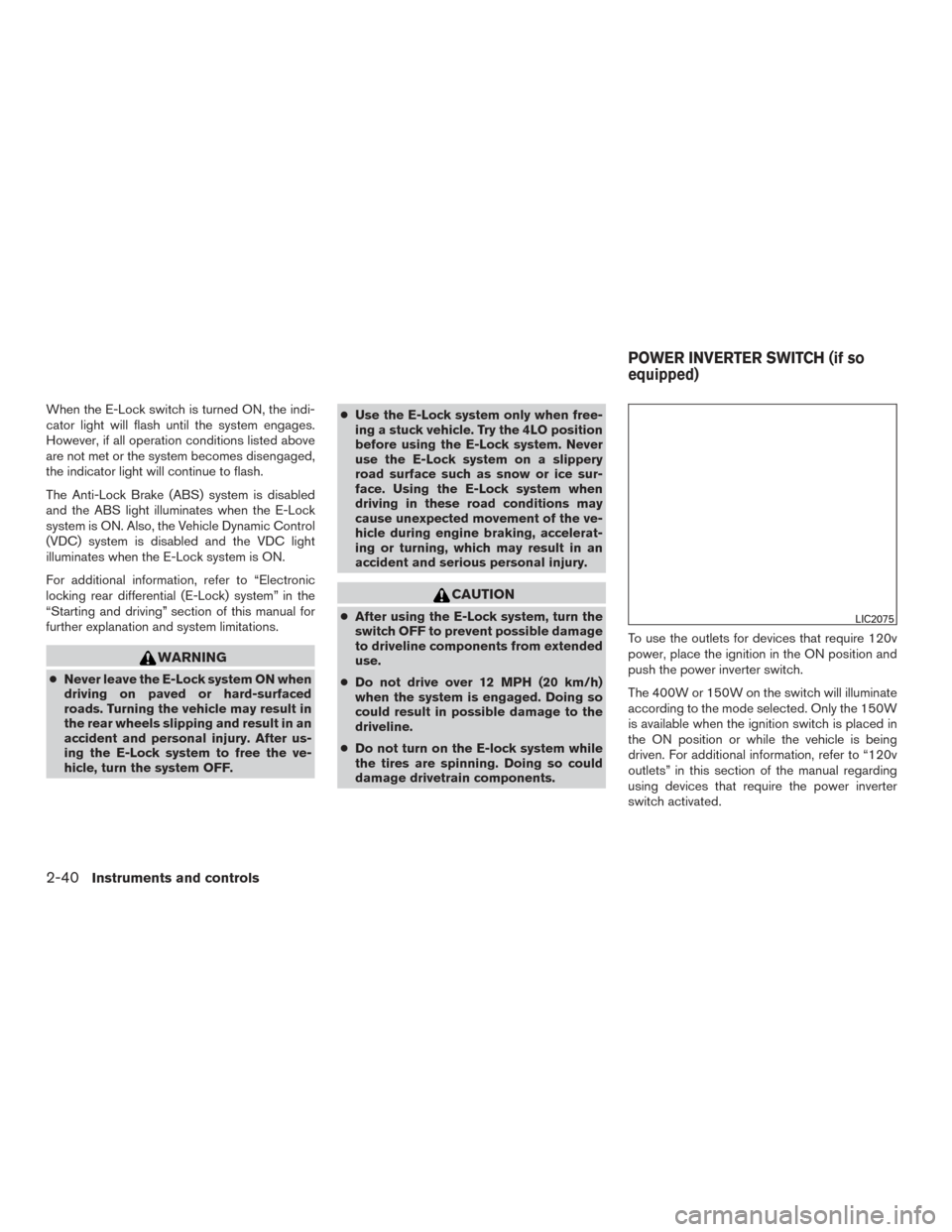
When the E-Lock switch is turned ON, the indi-
cator light will flash until the system engages.
However, if all operation conditions listed above
are not met or the system becomes disengaged,
the indicator light will continue to flash.
The Anti-Lock Brake (ABS) system is disabled
and the ABS light illuminates when the E-Lock
system is ON. Also, the Vehicle Dynamic Control
(VDC) system is disabled and the VDC light
illuminates when the E-Lock system is ON.
For additional information, refer to “Electronic
locking rear differential (E-Lock) system” in the
“Starting and driving” section of this manual for
further explanation and system limitations.
WARNING
●Never leave the E-Lock system ON when
driving on paved or hard-surfaced
roads. Turning the vehicle may result in
the rear wheels slipping and result in an
accident and personal injury. After us-
ing the E-Lock system to free the ve-
hicle, turn the system OFF. ●
Use the E-Lock system only when free-
ing a stuck vehicle. Try the 4LO position
before using the E-Lock system. Never
use the E-Lock system on a slippery
road surface such as snow or ice sur-
face. Using the E-Lock system when
driving in these road conditions may
cause unexpected movement of the ve-
hicle during engine braking, accelerat-
ing or turning, which may result in an
accident and serious personal injury.
CAUTION
● After using the E-Lock system, turn the
switch OFF to prevent possible damage
to driveline components from extended
use.
● Do not drive over 12 MPH (20 km/h)
when the system is engaged. Doing so
could result in possible damage to the
driveline.
● Do not turn on the E-lock system while
the tires are spinning. Doing so could
damage drivetrain components. To use the outlets for devices that require 120v
power, place the ignition in the ON position and
push the power inverter switch.
The 400W or 150W on the switch will illuminate
according to the mode selected. Only the 150W
is available when the ignition switch is placed in
the ON position or while the vehicle is being
driven. For additional information, refer to “120v
outlets” in this section of the manual regarding
using devices that require the power inverter
switch activated.LIC2075
POWER INVERTER SWITCH (if so
equipped)
2-40Instruments and controls
Page 292 of 457
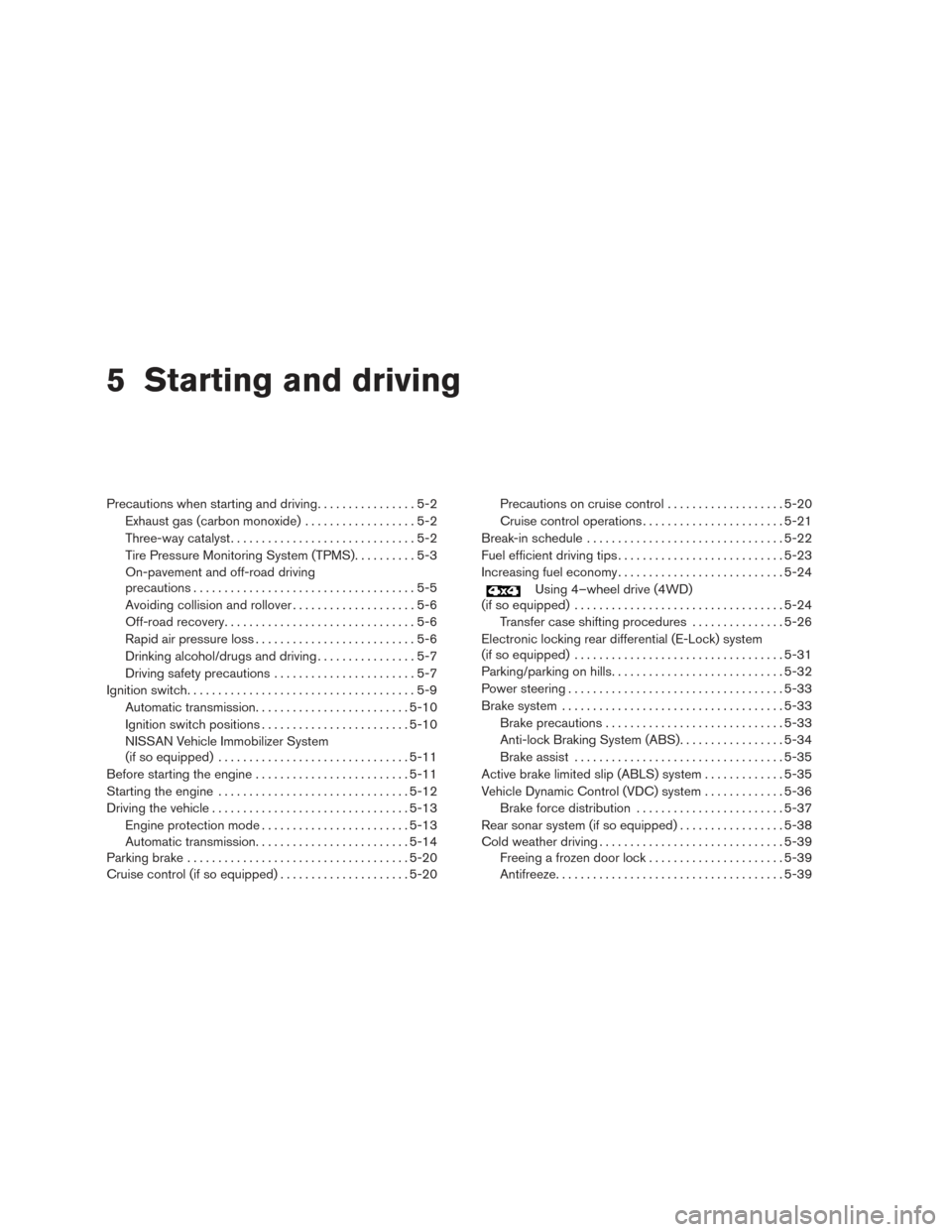
5 Starting and driving
Precautions when starting and driving................5-2
Exhaust gas (carbon monoxide) ..................5-2
Three-way catalyst ..............................5-2
Tire Pressure Monitoring System (TPMS) ..........5-3
On-pavement and off-road driving
precautions ....................................5-5
Avoiding collision and rollover . . ..................5-6
Off-road recovery ...............................5-6
Rapid air pressure loss ..........................5-6
Drinking alcohol/drugs and driving ................5-7
Driving safety precautions .......................5-7
Ignition switch .....................................5-9
Automatic transmission ......................... 5-10
Ignition switch positions ........................ 5-10
NISSAN Vehicle Immobilizer System
(if so equipped) ............................... 5-11
Before starting the engine ......................... 5-11
Starting the engine ............................... 5-12
Driving the vehicle ................................ 5-13
Engine protection mode ........................ 5-13
Automatic transmission ......................... 5-14
Parking brake .................................... 5-20
Cruise control (if so equipped) .....................5-20Precautions on cruise control
...................5-20
Cruise control operations .......................5-21
Break-in schedule ................................ 5-22
Fuel efficient driving tips ........................... 5-23
Increasing fuel economy ........................... 5-24
Using 4–wheel drive (4WD)
(if so equipped) .................................. 5-24
Transfer case shifting procedures . . .............5-26
Electronic locking rear differential (E-Lock) system
(if so equipped) .................................. 5-31
Parking/parking on hills ............................ 5-32
Power steering ................................... 5-33
Brake system .................................... 5-33
Brake precautions ............................. 5-33
Anti-lock Braking System (ABS) .................5-34
Brake assist .................................. 5-35
Active brake limited slip (ABLS) system .............5-35
Vehicle Dynamic Control (VDC) system .............5-36
Brake force distribution ........................ 5-37
Rear sonar system (if so equipped) .................5-38
Cold weather driving .............................. 5-39
Freeing a frozen door lock ......................5-39
Antifreeze ..................................... 5-39
Page 320 of 457
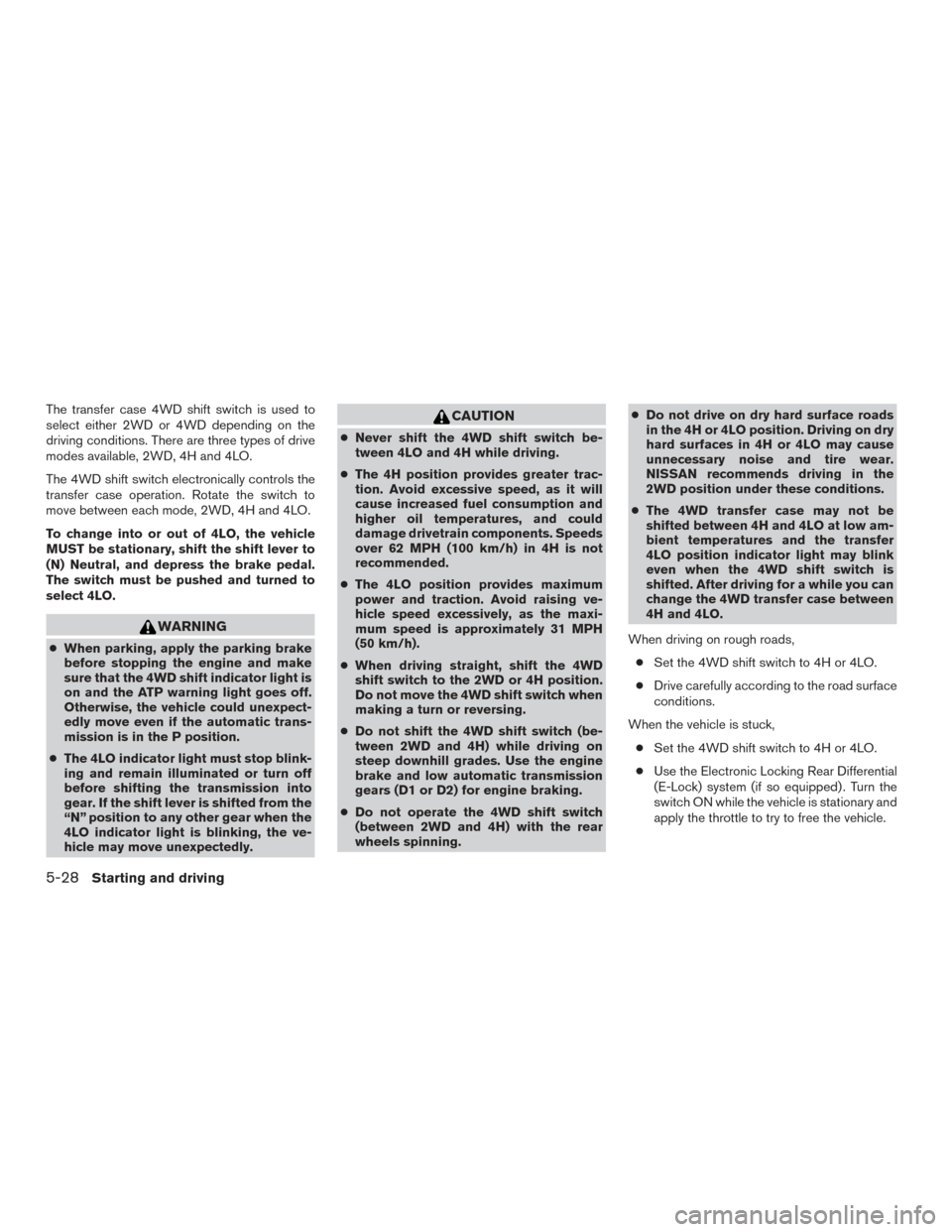
The transfer case 4WD shift switch is used to
select either 2WD or 4WD depending on the
driving conditions. There are three types of drive
modes available, 2WD, 4H and 4LO.
The 4WD shift switch electronically controls the
transfer case operation. Rotate the switch to
move between each mode, 2WD, 4H and 4LO.
To change into or out of 4LO, the vehicle
MUST be stationary, shift the shift lever to
(N) Neutral, and depress the brake pedal.
The switch must be pushed and turned to
select 4LO.
WARNING
●When parking, apply the parking brake
before stopping the engine and make
sure that the 4WD shift indicator light is
on and the ATP warning light goes off.
Otherwise, the vehicle could unexpect-
edly move even if the automatic trans-
mission is in the P position.
● The 4LO indicator light must stop blink-
ing and remain illuminated or turn off
before shifting the transmission into
gear. If the shift lever is shifted from the
“N” position to any other gear when the
4LO indicator light is blinking, the ve-
hicle may move unexpectedly.
CAUTION
● Never shift the 4WD shift switch be-
tween 4LO and 4H while driving.
● The 4H position provides greater trac-
tion. Avoid excessive speed, as it will
cause increased fuel consumption and
higher oil temperatures, and could
damage drivetrain components. Speeds
over 62 MPH (100 km/h) in 4H is not
recommended.
● The 4LO position provides maximum
power and traction. Avoid raising ve-
hicle speed excessively, as the maxi-
mum speed is approximately 31 MPH
(50 km/h).
● When driving straight, shift the 4WD
shift switch to the 2WD or 4H position.
Do not move the 4WD shift switch when
making a turn or reversing.
● Do not shift the 4WD shift switch (be-
tween 2WD and 4H) while driving on
steep downhill grades. Use the engine
brake and low automatic transmission
gears (D1 or D2) for engine braking.
● Do not operate the 4WD shift switch
(between 2WD and 4H) with the rear
wheels spinning. ●
Do not drive on dry hard surface roads
in the 4H or 4LO position. Driving on dry
hard surfaces in 4H or 4LO may cause
unnecessary noise and tire wear.
NISSAN recommends driving in the
2WD position under these conditions.
● The 4WD transfer case may not be
shifted between 4H and 4LO at low am-
bient temperatures and the transfer
4LO position indicator light may blink
even when the 4WD shift switch is
shifted. After driving for a while you can
change the 4WD transfer case between
4H and 4LO.
When driving on rough roads, ● Set the 4WD shift switch to 4H or 4LO.
● Drive carefully according to the road surface
conditions.
When the vehicle is stuck, ● Set the 4WD shift switch to 4H or 4LO.
● Use the Electronic Locking Rear Differential
(E-Lock) system (if so equipped) . Turn the
switch ON while the vehicle is stationary and
apply the throttle to try to free the vehicle.
5-28Starting and driving
Page 323 of 457

●When the warning light comes on, the
2WD mode may be engaged even if the
4WD shift switch is in 4H. Be especially
careful when driving. If corresponding
parts are malfunctioning, the 4WD
mode will not be engaged even if the
4WD shift switch is shifted.
● Do not drive the vehicle in the 4H or 4LO
position on dry hard surface roads. Driv-
ing on dry, hard surfaces in 4H or 4LO
may cause unnecessary noise, tire wear
and increased fuel consumption.
If the 4WD warning light turns on when
you are driving on dry hard surface roads:
– in the 4H position, shift the 4WD shift switch to 2WD.
– in the 4LO position, stop the vehicle, move the automatic transmission
shift lever to the N position with the
brake pedal depressed, and shift the
4WD shift switch to 2WD.
●
If the warning light is still on after the
above operation, have your vehicle
checked by a NISSAN dealer as soon as
possible.
● The transfer case may be damaged if
you continue driving with the warning
light blinking. The E-Lock system can provide additional trac-
tion and should only be used when a vehicle has
become or is becoming stuck. This system oper-
ates by electronically “locking” the two rear drive
wheels together, allowing them to turn at the
same speed. The system is used when it is not
possible to free a stuck vehicle even when using
the 4LO position (4-wheel drive vehicles) .
When added traction is required, activate the
E-Lock system by pushing the switch ON. For
additional information, refer to “Electronic locking
rear differential (E-Lock) system switch” in the
“Instruments and Controls” section of this
manual. Once the system fully engages, the indi-
cator light in the instrument panel will remain ON.
When the system is activated, both rear wheels
will engage, providing added traction.
The rear wheels may momentarily slip or move to
engage the system, and the system will only
engage up to approximately 4 MPH (7 km/h).
Once the vehicle is free, the system should be
turned OFF and driving resumed.
The Anti-Lock Brake (ABS) system is disabled
and the ABS light illuminates when the E-Lock
system is ON. Also, the Vehicle Dynamic Control
(VDC) system is disabled and the VDC light
illuminates when the E-Lock system is ON.
WARNING
●
Never leave the E-Lock system ON when
driving on paved or hard-surfaced
roads. Turning the vehicle may result in
the rear wheels slipping and result in an
accident and personal injury. After us-
ing the E-Lock system to free the ve-
hicle, turn the system OFF.
● Use the E-Lock system only when free-
ing a stuck vehicle. Try the 4LO position
before using the E-Lock system. Never
use the E-Lock system on a slippery
road surface such as snow or ice sur-
face. Using the E-Lock system when
driving in these road conditions may
cause unexpected movement of the ve-
hicle during engine braking, accelerat-
ing or turning, which may result in an
accident and serious personal injury.
ELECTRONIC LOCKING REAR
DIFFERENTIAL (E-Lock) SYSTEM (if
so equipped)
Starting and driving5-31
Page 340 of 457
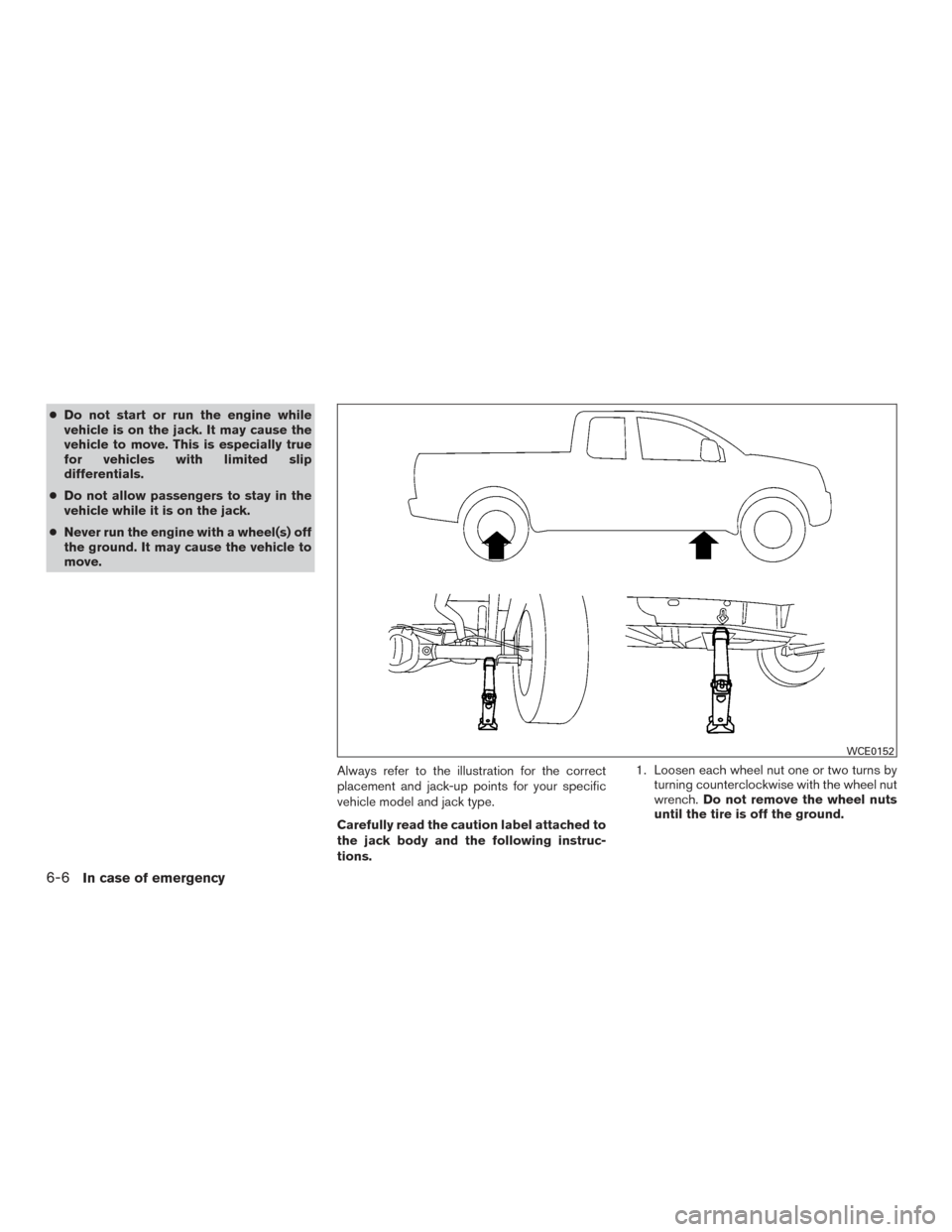
●Do not start or run the engine while
vehicle is on the jack. It may cause the
vehicle to move. This is especially true
for vehicles with limited slip
differentials.
● Do not allow passengers to stay in the
vehicle while it is on the jack.
● Never run the engine with a wheel(s) off
the ground. It may cause the vehicle to
move.
Always refer to the illustration for the correct
placement and jack-up points for your specific
vehicle model and jack type.
Carefully read the caution label attached to
the jack body and the following instruc-
tions. 1. Loosen each wheel nut one or two turns by
turning counterclockwise with the wheel nut
wrench. Do not remove the wheel nuts
until the tire is off the ground.
WCE0152
6-6In case of emergency
Page 403 of 457
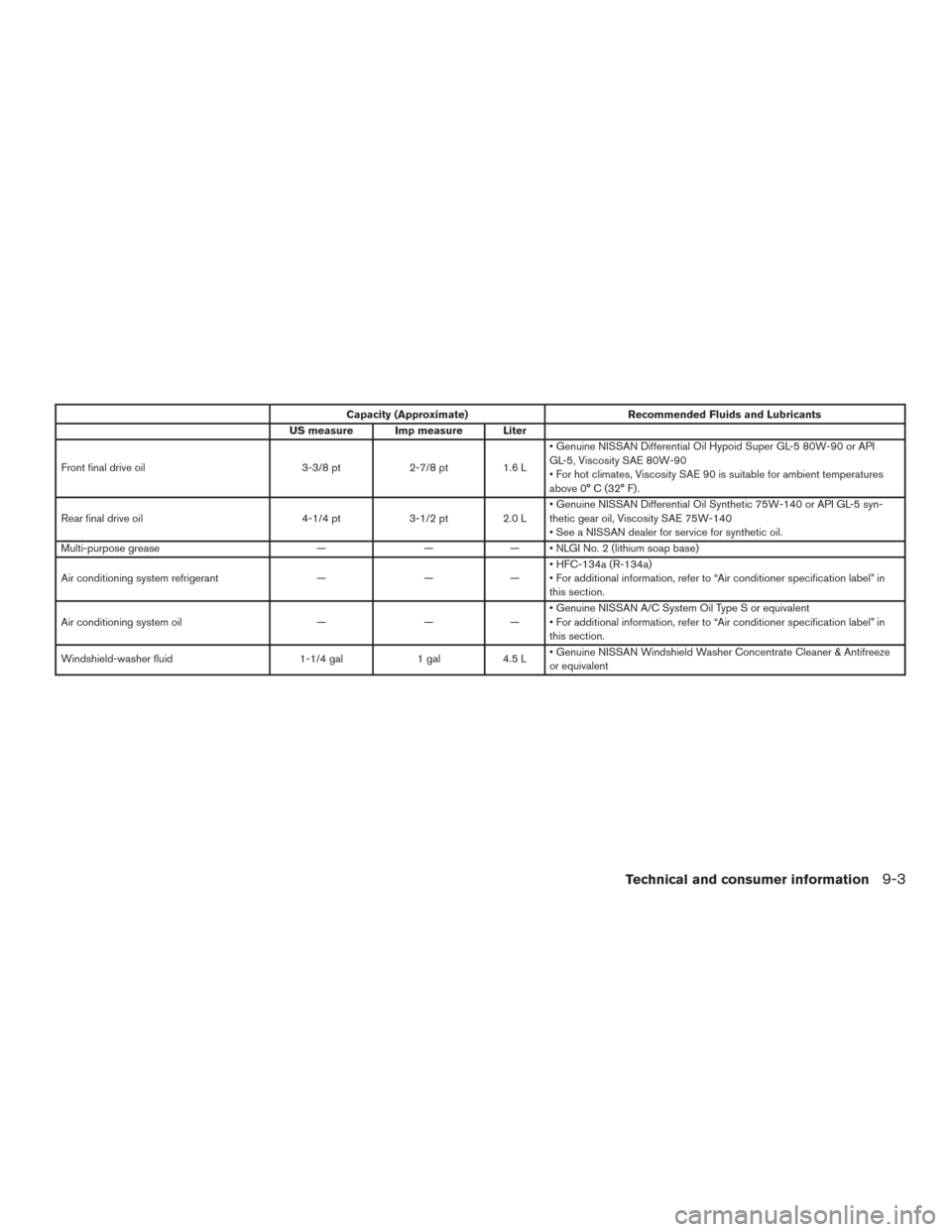
Capacity (Approximate)Recommended Fluids and Lubricants
US measure Imp measure Liter
Front final drive oil 3-3/8 pt2-7/8 pt1.6 L• Genuine NISSAN Differential Oil Hypoid Super GL-5 80W-90 or API
GL-5, Viscosity SAE 80W-90
• For hot climates, Viscosity SAE 90 is suitable for ambient temperatures
above 0° C (32° F) .
Rear final drive oil 4-1/4 pt3-1/2 pt2.0 L• Genuine NISSAN Differential Oil Synthetic 75W-140 or API GL-5 syn-
thetic gear oil, Viscosity SAE 75W-140
• See a NISSAN dealer for service for synthetic oil.
Multi-purpose grease ——— • NLGI No. 2 (lithium soap base)
Air conditioning system refrigerant ———• HFC-134a (R-134a)
• For additional information, refer to “Air conditioner specification label” in
this section.
Air conditioning system oil ———• Genuine NISSAN A/C System Oil Type S or equivalent
• For additional information, refer to “Air conditioner specification label” in
this section.
Windshield-washer fluid 1-1/4 gal1 gal4.5 L• Genuine NISSAN Windshield Washer Concentrate Cleaner & Antifreeze
or equivalent
Technical and consumer information9-3
Page 448 of 457
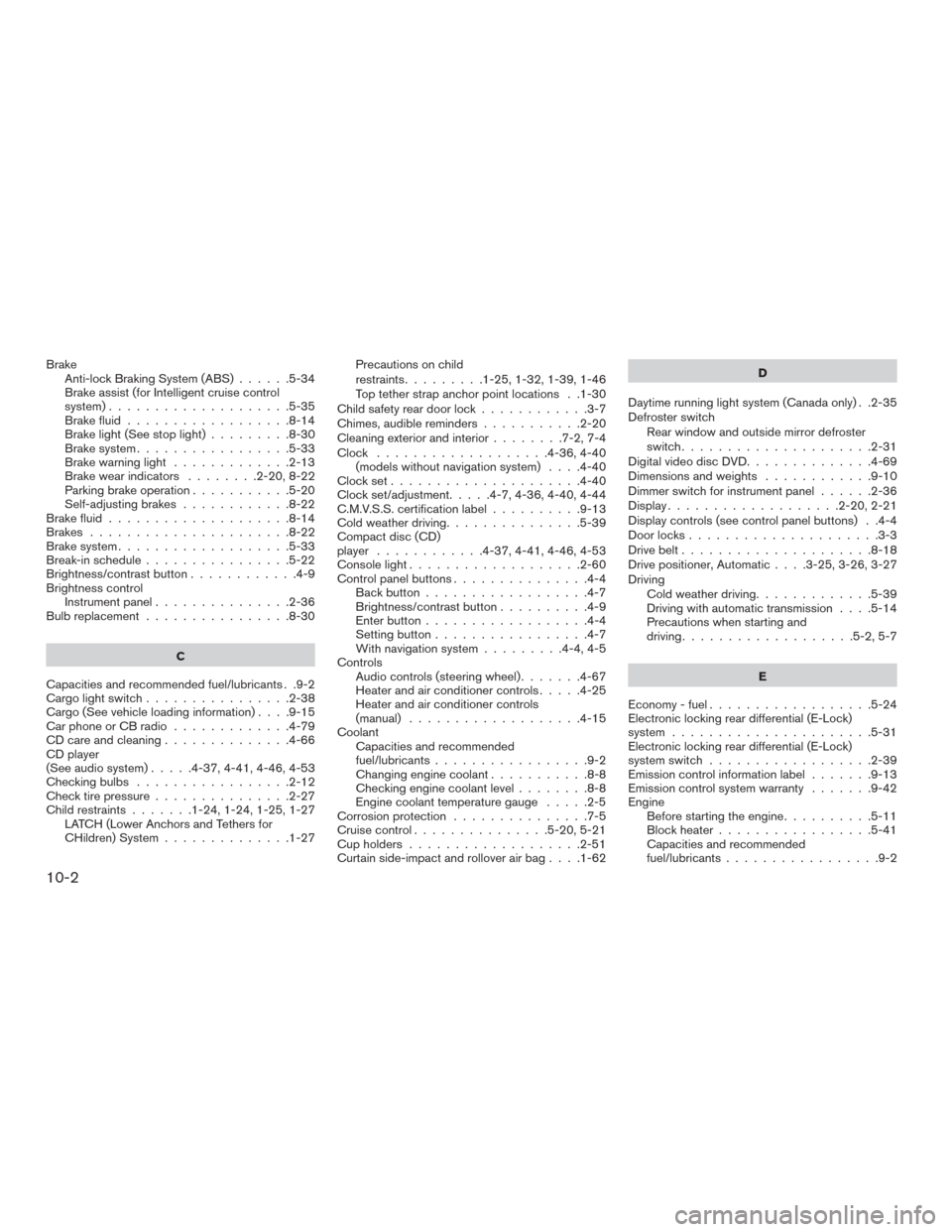
BrakeAnti-lock Braking System (ABS) ......5-34
Brake assist (for Intelligent cruise control
system)....................5-35
Brake fluid ..................8-14
Brake light (See stop light) .........8-30
Brake system .................5-33
Brake warning light .............2-13
Brake wear indicators ........2-20,8-22
Parking brake operation ...........5-20
Self-adjusting brakes ............8-22
Brake fluid ....................8-14
Brakes ......................8-22
Brake system ...................5-33
Break-in schedule ................5-22
Brightness/contrastbutton............4-9
Brightness control Instrument panel ...............2-36
Bulb replacement ................8-30
C
Capacities and recommended fuel/lubricants . .9-2
Cargolightswitch................2-38
Cargo(Seevehicleloadinginformation)....9-15
Car phone or CB radio .............4-79
CD care and cleaning ..............4-66
CD player
(See audio system) .....4-37,4-41,4-46,4-53
Checkingbulbs .................2-12
Check tire pressure ...............2-27
Child restraints .......1-24,1-24,1-25,1-27
LATCH (Lower Anchors and Tethers for
CHildren) System ..............1-27 Precautions on child
restraints
.........1-25,1-32,1-39,1-46
Top tether strap anchor point locations . .1-30
Child safety rear door lock ............3-7
Chimes,audiblereminders...........2-20
Cleaning exterior and interior ........7-2,7-4
Clock ...................4-36,4-40 (models without navigation system) ....4-40
Clockset.....................4-40
Clock set/adjustment.....4-7,4-36,4-40,4-44
C.M.V.S.S. certification label ..........9-13
Cold weather driving ...............5-39
Compact disc (CD)
player ............4-37,4-41,4-46,4-53
Console light ...................2-60
Control panel buttons ...............4-4
Back button ..................4-7
Brightness/contrast button ..........4-9
Enterbutton..................4-4
Setting button .................4-7
With navigation system .........4-4,4-5
Controls Audio controls (steering wheel) .......4-67
Heater and air conditioner controls .....4-25
Heater and air conditioner controls
(manual) ...................4-15
Coolant Capacities and recommended
fuel/lubricants .................9-2
Changingenginecoolant...........8-8
Checking engine coolant level ........8-8
Engine coolant temperature gauge .....2-5
Corrosion protection ...............7-5
Cruisecontrol...............5-20,5-21
Cupholders...................2-51
Curtainside-impactandrolloverairbag....1-62 D
Daytime running light system (Canada only) . .2-35
Defroster switch Rear window and outside mirror defroster
switch .....................2-31
Digital video disc DVD ..............4-69
Dimensionsandweights ............9-10
Dimmer switch for instrument panel ......2-36
Display...................2-20,2-21
Display controls (see control panel buttons) . .4-4
Door locks .....................3-3
Drive belt .....................8-18
Drive
positioner, Automatic ....3-25,3-26,3-27
Driving Cold weather driving .............5-39
Driving with automatic transmission ....5-14
Precautions when starting and
driving ...................5-2,5-7
E
Economy-fuel..................5-24
Electronic locking rear differential (E-Lock)
system ......................5-31
Electronic locking rear differential (E-Lock)
system switch ..................2-39
Emission control information label .......9-13
Emission control system warranty .......9-42
Engine Before starting the engine ..........5-11
Blockheater.................5-41
Capacities and recommended
fuel/lubricants.................9-2
10-2
Page 452 of 457
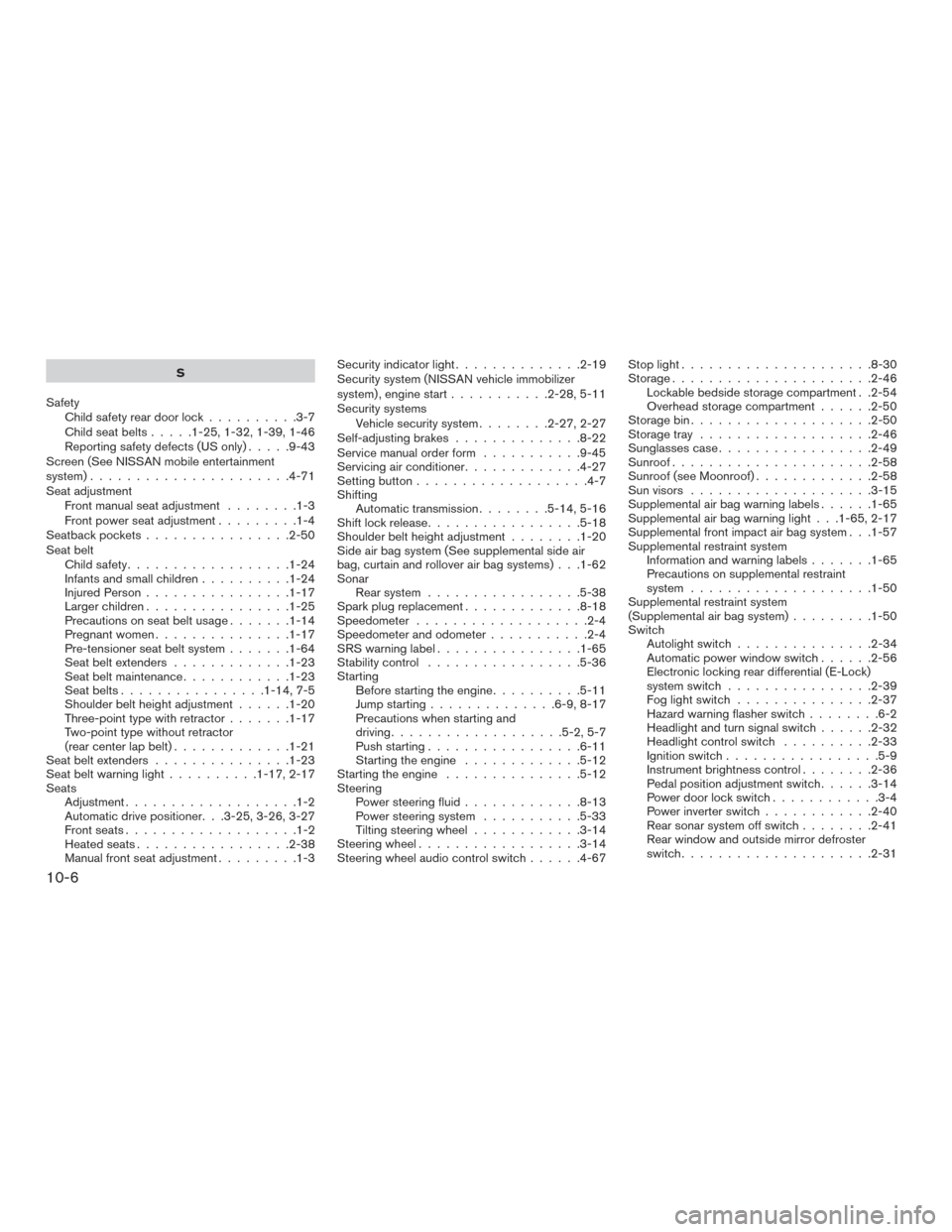
S
Safety Child safety rear door lock ..........3-7
Childseatbelts.....1-25,1-32,1-39,1-46
Reporting safety defects (US only) .....9-43
Screen (See NISSAN mobile entertainment
system)......................4-71
Seat adjustment Front manual seat adjustment ........1-3
Front power seat adjustment .........1-4
Seatback pockets ................2-50
Seat belt Childsafety..................1-24
Infantsandsmallchildren..........1-24
Injured Person ................1-17
Largerchildren................1-25
Precautionsonseatbeltusage.......1-14
Pregnant women ...............1-17
Pre-tensioner seat belt system .......1-64
Seat belt extenders .............1-23
Seat belt maintenance ............1-23
Seat belts ................1-14,7-5
Shoulder belt height adjustment ......1-20
Three-point type with retractor .......1-17
Two-point type without retractor
(rear center lap belt) .............1-21
Seat belt extenders ...............1-23
Seatbeltwarninglight..........1-17,2-17
Seats Adjustment ...................1-2
Automatic drive positioner. . .3-25, 3-26, 3-27
Frontseats...................1-2
Heatedseats.................2-38
Manual front seat adjustment .........1-3Security indicator light
..............2-19
Security system (NISSAN vehicle immobilizer
system) , engine start ...........2-28,5-11
Security systems Vehicle security system ........2-27,2-27
Self-adjusting brakes ..............8-22
Service manual order form ...........9-45
Servicing air conditioner .............4-27
Setting button ...................4-7
Shifting Automatic transmission ........5-14,5-16
Shiftlockrelease.................5-18
Shoulder belt height adjustment ........1-20
Side air bag system (See supplemental side air
bag, curtain and rollover air bag systems) . . .1-62
Sonar Rear system .................5-38
Sparkplugreplacement.............8-18
Speedometer ...................2-4
Speedometer and odometer ...........2-4
SRSwarninglabel................1-65
Stability control .................5-36
Starting Before starting the engine ..........5-11
Jump starting ..............6-9,8-17
Precautions when starting and
driving ...................5-2,5-7
Push starting .................6-11
Starting the engine .............5-12
Starting the engine ...............5-12
Steering Power steering fluid .............8-13
Power steering system ...........5-33
Tilting steering wheel ............3-14
Steeringwheel..................3-14
Steering wheel audio control switch ......4-67Stoplight.....................8-30
Storage......................2-46
Lockable bedside storage compartment . .2-54
Overhead storage compartment ......2-50
Storagebin....................2-50
Storage tray ...................2-46
Sunglasses case .................2-49
Sunroof......................2-58
Sunroof(seeMoonroof).............2-58
Sun visors ....................
3-15
Supplemental air bag warning labels ......1-65
Supplemental air bag warning light . . .1-65, 2-17
Supplemental front impact air bag system . . .1-57
Supplemental restraint system Information and warning labels .......1-65
Precautions on supplemental restraint
system ....................1-50
Supplemental restraint system
(Supplemental air bag system) .........1-50
Switch Autolightswitch...............2-34
Automatic power window switch ......2-56
Electronic locking rear differential (E-Lock)
system switch ................2-39
Fog light switch ...............2-37
Hazard warning flasher switch ........6-2
Headlightandturnsignalswitch......2-32
Headlight control switch ..........2-33
Ignition switch .................5-9
Instrument brightness control ........2-36
Pedal position adjustment switch ......3-14
Power door lock switch ............3-4
Power inverter switch ............2-40
Rear sonar system off switch ........2-41
Rear window and outside mirror defroster
switch .....................2-31
10-6